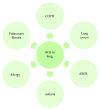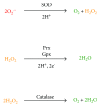Reactive Oxygen Species in Chronic Obstructive Pulmonary Disease
- PMID: 29599897
- PMCID: PMC5828402
- DOI: 10.1155/2018/5730395
Reactive Oxygen Species in Chronic Obstructive Pulmonary Disease
Abstract
Chronic obstructive pulmonary disease (COPD) includes chronic bronchitis and emphysema. Environmental exposure, primarily cigarette smoking, can cause high oxidative stress and is the main factor of COPD development. Cigarette smoke also contributes to the imbalance of oxidant/antioxidant due to exogenous reactive oxygen species (ROS). Moreover, endogenously released ROS during the inflammatory process and mitochondrial dysfunction may contribute to this disease progression. ROS and reactive nitrogen species (RNS) can oxidize different biomolecules such as DNA, proteins, and lipids leading to epithelial cell injury and death. Various detoxifying enzymes and antioxidant defense systems can be involved in ROS removal. In this review, we summarize the main findings regarding the biological role of ROS, which may contribute to COPD development, and cytoprotective mechanisms against this disease progression.
Figures





Similar articles
-
Oxidative stress and free radicals in COPD--implications and relevance for treatment.Int J Chron Obstruct Pulmon Dis. 2014 Oct 17;9:1207-24. doi: 10.2147/COPD.S51226. eCollection 2014. Int J Chron Obstruct Pulmon Dis. 2014. PMID: 25378921 Free PMC article. Review.
-
Update in chronic obstructive pulmonary disease: role of antioxidant and metabolizing gene polymorphisms.Exp Lung Res. 2011 Aug;37(6):364-75. doi: 10.3109/01902148.2011.580416. Epub 2011 Jul 1. Exp Lung Res. 2011. PMID: 21721950 Review.
-
Mitochondrial alterations during oxidative stress in chronic obstructive pulmonary disease.Int J Chron Obstruct Pulmon Dis. 2017 Apr 13;12:1153-1162. doi: 10.2147/COPD.S130168. eCollection 2017. Int J Chron Obstruct Pulmon Dis. 2017. PMID: 28458526 Free PMC article. Review.
-
Reactive Oxygen Species and Antioxidative Defense in Chronic Obstructive Pulmonary Disease.Antioxidants (Basel). 2021 Sep 28;10(10):1537. doi: 10.3390/antiox10101537. Antioxidants (Basel). 2021. PMID: 34679673 Free PMC article. Review.
-
Cigarette smoke induces an unfolded protein response in the human lung: a proteomic approach.Am J Respir Cell Mol Biol. 2008 May;38(5):541-50. doi: 10.1165/rcmb.2007-0221OC. Epub 2007 Dec 13. Am J Respir Cell Mol Biol. 2008. PMID: 18079489
Cited by
-
Disinherit your Descendants by Rewriting the Chronic Pulmonary Obstructive Disease Epigenetic Script.Am J Respir Cell Mol Biol. 2024 Mar;70(3):153-154. doi: 10.1165/rcmb.2023-0387ED. Am J Respir Cell Mol Biol. 2024. PMID: 38060824 Free PMC article. No abstract available.
-
Necroptosis Mediates Cigarette Smoke-Induced Inflammatory Responses in Macrophages.Int J Chron Obstruct Pulmon Dis. 2020 May 18;15:1093-1101. doi: 10.2147/COPD.S233506. eCollection 2020. Int J Chron Obstruct Pulmon Dis. 2020. PMID: 32546997 Free PMC article.
-
NADPH oxidase-derived reactive oxygen species: Dosis facit venenum.Exp Physiol. 2019 Apr;104(4):447-452. doi: 10.1113/EP087125. Epub 2019 Mar 7. Exp Physiol. 2019. PMID: 30737851 Free PMC article. Review.
-
Molecular and Cellular Effects of Microplastics and Nanoplastics: Focus on Inflammation and Senescence.Cells. 2024 Oct 29;13(21):1788. doi: 10.3390/cells13211788. Cells. 2024. PMID: 39513895 Free PMC article. Review.
-
Relationships among smoking, oxidative stress, inflammation, macromolecular damage, and cancer.Mutat Res Rev Mutat Res. 2021 Jan-Jun;787:108365. doi: 10.1016/j.mrrev.2021.108365. Epub 2021 Jan 11. Mutat Res Rev Mutat Res. 2021. PMID: 34083039 Free PMC article. Review.
References
Publication types
MeSH terms
Substances
Grants and funding
LinkOut - more resources
Full Text Sources
Other Literature Sources
Medical

